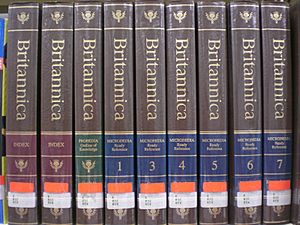Micropædia facts for kids
The Micropædia is a special set of books that are part of the Encyclopædia Britannica. Think of it as one of three main parts of a very big encyclopedia. The name Micropædia comes from two words: "micro," which means small, and "encyclopedia." So, it's like a "small encyclopedia." It has many short articles that help you quickly find information. This is different from the Macropædia, which has much longer and more detailed articles.
Contents
What is the Micropædia?
The Micropædia is designed for quick checks. It gives you the main facts about a topic without going into too much detail. It's perfect if you just need to know the basics. It also helps you find the longer articles in the Macropædia if you want to learn more.
How Many Articles Does It Have?
When the Micropædia first came out in 1974, it had 10 books. These books contained over 102,000 short articles. Each article was less than 750 words long. Later, in the 15th edition of the encyclopedia, many of these short articles were combined. Now, the Micropædia has about 65,000 articles spread across 12 books.
Article Length and Detail
Most articles in the Micropædia are still very short, usually just one or two paragraphs. They keep the 750-word limit. However, some newer articles, like the one about the Internet, can be longer. These longer articles might even fill a whole page.
Who Writes the Articles?
Most of the 65,000 articles in the Micropædia do not list the names of the people who wrote them. They also usually do not have a list of books or sources used to write them. This is because they are meant for quick reference. If you need more detailed information or want to know the sources, you would look at the longer articles in the Macropædia.
See also
 In Spanish: Micropædia for kids
In Spanish: Micropædia for kids


